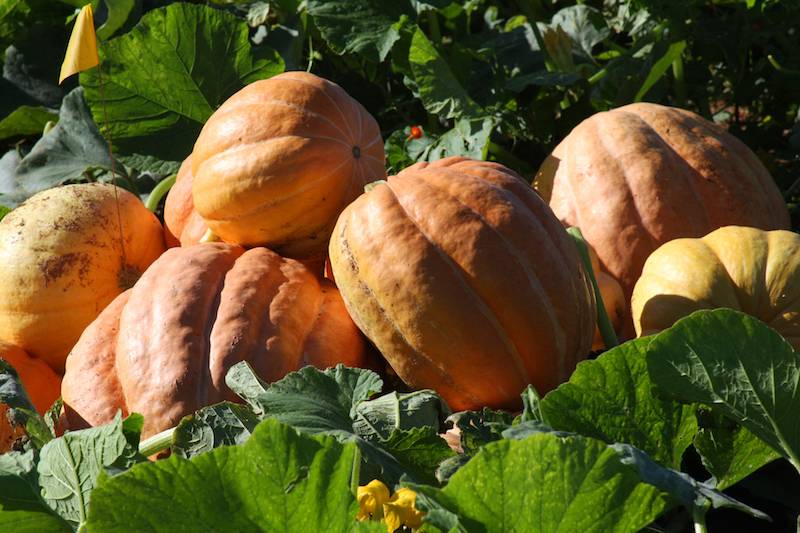This time of year, University of Georgia horticulturist George Boyhan’s mind turns to pumpkin carving.
He and his team have already carved hundreds of pumpkins this fall, but you’re unlikely to see the fruits of their labor on anyone’s front porch or in any carving contests. When Boyhan carves, he’s not after the perfect jack-o’-lantern smile or an artsy silhouetted landscape. He’s after the seeds.
“We use a reciprocating saw — like those used in construction,” Boyhan said.
It’s not a delicate process, but it’s a critical one for the handful of Southeastern pick-your-own and organic pumpkin growers who depend on Boyhan’s university-developed Orange Bulldog pumpkin seeds.
For the past two years, poor seed germination meant that supplies of the Orange Bulldog pumpkin seed were slim, causing a problem for growers in Georgia working to produce pumpkins for local markets. This year, after a great growing season, they’re back.
While Georgia is the fifth largest producer of vegetables in the country, farmers here only grow about 300 acres of pumpkins annually because traditional pumpkins are difficult to grow in the state, said Boyhan, who breeds vegetable crops as part of his research at UGA. Traditional pumpkins constantly battle insect-borne diseases this far south, even with a chemical pesticide regimen.
“You might be successful one out of three years, and that’s not a very good ratio,” he said.
Boyhan developed the Orange Bulldog pumpkin to resist many of these diseases, and it’s become a staple for pick-your-own and farmers market pumpkin producers. It’s a standard jack-o’-lantern-sized pumpkin, but features colors ranging from salmon to burnt orange.
Its reliability has made it popular, and it was still growing in popularity when the seeds fell into short supply.
A craft pumpkin for craft growers
Unlike the pumpkins that grow well in the Midwest and further north on the Eastern Seaboard, called “Cucurbita pepo,” Boyhan bred the Orange Bulldog from a species of wild winter squash found in the jungles of South America, known as “Cucurbita maxima.”
It took Boyhan years of selecting the most round, orange squashes to generate seeds that would routinely produce a large, orange squash that could be used like a traditional pumpkin.
His work has opened the door for many small operations to turn pumpkins into serious business.
In 2010, after visiting a successful pumpkin patch farm in Omaha, Nebraska, Melissa Reagan, of Madrac Farms in Effingham County, wanted to build a pick-your-own farm around a pumpkin patch.
“I got home, and I learned that ‘pumpkins won’t grow here,’ but then I heard about the Orange Bulldog pumpkin UGA had just put out,” Reagan said.
Since then she’s relied on the Orange Bulldog pumpkin to help her generate tremendous traffic at her family’s five-acre pumpkin patch on their 22-acre farm. The Reagans opened for the season on Oct. 2 and have already seen 3,400 visitors.
They offer a petting zoo, corn maze, bonfire, hay castle and hayrides, but the stars of the farm in October are the pumpkins.
With Orange Bulldog seeds in short supply this year, Reagan mixed a more traditional pumpkin variety and a white pumpkin variety into her pumpkin patch to fill the rows. She immediately saw the difference. She sprayed to keep the insects down but still had a tremendous pickleworm problem.
“I don’t think we would have [built our pumpkin patch business] without this variety being available,” Reagan said. To me it’s not a true a pumpkin patch if they’re not growing in the field where you pick them out… If I could plant 10 acres of [the Orange Bulldog pumpkins], I would. The amount of money that I needed to put into sprays for the other varieties was overwhelming, and we still have had problems with pickleworms.”
She should be able to get plenty of Orange Bulldog seed for the 2015 season.
Boyhan doesn’t think he’ll see this kind of shortage again, and he’s working on new varieties—a larger Cucurbita maxima variety like the Orange Bulldog as well as a more disease-resistant variety of the traditional Cucurbita pepo pumpkin.
Anyone seeking more information about the Orange Bulldog pumpkin can visit orangebulldogpumpkin.uga.edu.




